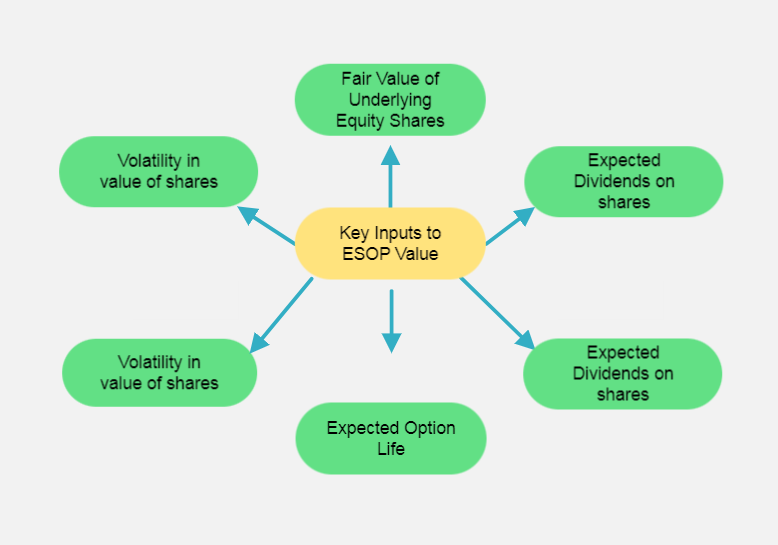Introduction
An employee stock ownership plan (ESOP) is a method of rewarding employees that gives them a share of the company’s ownership. Employees are offered stocks of the company at a low or no additional cost that they can encash after a specific period at a particular price. Companies often use ESOPs as a corporate-finance strategy to align the interests of their employees with those of their shareholders.
ESOP schemes give employees a Call Option which means they have no obligations and have the right to buy the shares of the company on a predestined date at a predestined price. The Call Option is at a discount to the Fair Market Value (FMV)
Section 2(37) of the Companies Act, 2013 defines employees stock option as ‘the option given to the directors, officers or employees of the company or of its holding company or subsidiary company or companies, if any, which gives such directors, officers or employees, the benefit or right to purchase, or to subscribe for, the shares of the company at a future date at a pre-determined price.’ This provision needs to be read with Rule 12 of The Companies (Share Capital and Debentures) Rules, 2014.
There is no minimum or maximum threshold on the quantum of ESOP or the number of employees participating in ESOP. Also, the employees issued shares under ESOP are not counted in the maximum limit of shareholder (200) in case of Private Company in terms of the definition of Private Company under the Companies Act.

Most companies which are backed by institutional investors (private equity or venture capital) have a stock option plan in place. Primarily used for employee retention and motivation, stock options provide employees with a chance for wealth creation rather than income generation.
The Sequence of Events
- Grant: Offering of ESOP Options from Company to Employee
- Vesting: Process through which employee becomes eligible to exercise options
- Exercise: When employee applies to Company for getting shares allotted
- Allotment – Pursuant to the exercise of the option, the company actually gets the shares allotted to the employees
Often the vesting is linked to underlying conditions like a performance target or the employee loyalty ( a counter to attrition)
In case of Stock Appreciation Rights (SAR), employee gets the benefit in the form of cash / equity which is the difference between the date of grant and final exercise of options
So, if the share price on Grant is INR 10/share and on the vesting is INR 50/share, the employee gets the difference of INR 40 through shares and cash
Regulatory Framework
For an Unlisted Company, we need to adhere to the
- Companies Act, 2013 + Rules
- Income Tax Act, 1961
For Listed Company, we also need to adhere to
- SEBI (SBEB) Regulations, 2014
- SEBI (LODR) Regulations, 2015
- SEBI (PIT) Regulations, 2015
If foreign employees are covered, Foreign Exchange Management Act, 1999 provisions also kick in. Companies falling under Approval Route need to obtain prior approval for issuing ESOPs. Form ESOP is required to be filed with AD-Bank within 30 days of Grant of Options. Form FC-GPR to be filed with AD-Bank within 30 days of allotment of shares
Implementation Framework
- For a Listed Company, the base price is Market price, one day before the date of Grant
- For an Unlisted Company, a price calculated on the basis of valuation done upon Grant
Companies are free to decide the Exercise price, discount / premium over it however, the Exercise price shall never go below the Par Value of Shares
The minimum vesting period of ESOPs granted under a scheme is minimum of one (1) year, whether Listed or Unlisted Company
Accounting for ESOPs
Ind AS) 102 - Share-based Payment specifies the financial reporting by an entity when it undertakes a share-based payment transaction. In particular, it requires an entity to reflect in its profit or loss and financial position the effects of share-based payment transactions, including expenses associated with transactions in which share options are granted to employees. This applies to both equity-settled share-based payment transactions as well as cash-settled share-based payment transactions
Point of Calculation is Grant and Period of Booking is Over vesting period
What is the timing for seeking valuation- is it at grant or at exercise?
We need to determine the intrinsic value/ fair value (as the case may be) of the Stock Options at the date of grant of the options. Accordingly, we can record the cost of the stock options in its books of accounts.
Further, for the purpose of determining income and taxes, an Unlisted Company needs to determine the fair market value of the shares at the time of exercise so it needs to seek a valuation of its shares on the exercise date. The price of shares of a Listed Company is known from the price quoted on the Stock Exchange, so the valuation of shares for taxation purpose is not required by it.
- an Unlisted Company must get valuation both at the time of grant of the options and the exercise of the options.
- a Listed Company needs valuation only for accounting purpose at the time of grant of the options.
The value of the Stock Options granted is a compensation cost of the employees that needs to be booked for ESOP accounting. Since this cost is incurred by the company over the vesting period, the estimated cost is measured on grant date and is booked systematically over the vesting period
Mandatory Valuation Exercise
The Income-tax Act, 1961 provides for taxation of ESOPs as a perquisite at the time of exercise, subject to the valuation of the perquisite as prescribed in the Income-tax Rules, 1962.
As per the IT rules, the taxable value of the ESOP on exercise is
Fair Market Value (FMV) of the share on the date of allotment / transfer of shares - Exercise Price paid by the employee.
The IT Rules provide for separate mechanism for determining the FMV for shares listed on a recognized stock exchange in India and for shares not listed on a recognized stock exchange in India. An unlisted company has to obtain a valuation certificate from a Category 1 Merchant Banker registered with SEBI as of a date not earlier than 180 days prior to date of exercise.
As far as Financial Reporting is concerned, for listed companies, there is no specification other than the valuation methodology; however, as it impacts the financial statements, auditors prefer valuations being carried out by trusted and efficient valuers with decent track records.
Method of Valuation
Depending on the level of accuracy desired and the complexity of the choices, fair value can be calculated using either of Black Scholes Formula, Binomial Method or Monte Carlo Method.
Black Scholes Formula is the most commonly used method, and it’s best for small schemes with straightforward rules. However, in case of unlisted companies, there are a host of caveats to the implementation of the framework. It often requires intricate modeling to incorporate unique terms and complex risks.

Fair Value of Underlying, especially in case of unlisted equity shares based on generally accepted methods like market multiples, DCF etc. We also need to adjust the valued via Discount for Lack of Control (DLOC), such that the value arrived at is at minority level and not control level
Exercise Price can be obtained from the part of the ESOP Scheme or Grant Letter
Expected Option Life considers
- Grant date
- Vesting date / period
- Exercise period
- Expiration date
- Expected early exercises during the eligible period if supported by history
This may also require weighted average computation for different vesting patterns within the same ESOP scheme
Expected Dividends - If the company has had a dividend history, then the same could be directly
Considered. But there is no dividend history, generally dividend history of comparable companies is analysed and considered. Remember that Dividend Yield is considered as % to fair value [not as % to face value]
Risk Free Rate – could simply be the G-Sec yields, as at the Valuation Date which is usually the Grant Date. The tenure is usually matched similar to the future expected option life considered in the option valuation model
Volatility is Measured using standard deviation as a basis. For listed shares, the computation is straight forward. For unlisted shares, volatility is computed for shares of comparable companies and then used as a proxy
Summing Up
ESOPS have clearly emerged as a preferred choice for both employers and employees, especially in the start-up ecosystem. For unlisted companies, valuation of ESOPs is a challenge due to lack of observable inputs. A lot of judgement is required. As professionals, it is incumbent upon us to ensure that there is due care taken to proper adherence to the governing compliance framework surrounding ESOPs , so that the exercise adds optimum value to our client.
The author, Anurag Singal has been a CA Rankholder and earned his MBA from IIM Ahmedabad. He is also a Registered Valuer for Securities /Financial Assets – IBBI. Prior to commencing practice, he has 14+ years of experience in the M&A/Financial Modelling and Valuation across companies like ITC, Tata Steel and Aditya Birla Group.







 CAclubindia
CAclubindia

